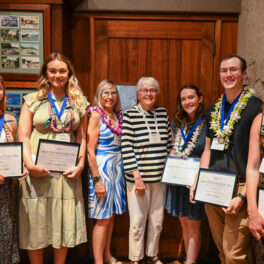Hawai‘i has been called the “extinction capital of the world.” But, with the exception of the islands’ birds, there has until now been no accurate assessment of the true level of this catastrophic loss. Invertebrates (insects, snails, spiders, etc.) constitute the vast majority of the species that make up Hawai‘i’s formerly spectacularly diverse and unique biota. A team of researchers, including scientists from the Pacific Biosciences Research Center (PBRC) at the University of Hawai‘i at Mānoa, the Bishop Museum in Honolulu, Howard University in Washington D.C., and the French National Museum of Natural History in Paris, recently published the first rigorous assessment of extinction of invertebrates in Hawai`i.
The team focused on the most diverse group of Hawaiian land snails, known as the family Amastridae, of which 325 species have been recognized – all known only from Hawai‘i. The researchers determined that only 15 of these species could still be found alive, and estimated that the rate of extinction may have been as high as 14 percent of the fauna per decade.
In a companion study published in the Proceedings of the National Academy of Sciences, members of the team, in collaboration with mathematics and bioinformatics specialists at the Pierre and Marie Curie University in Paris, addressed invertebrate extinction globally.
Since the 1980s, many biologists have concluded that the earth is in the midst of a massive biodiversity extinction crisis caused by human activities. Yet only around 800 of the planet’s 1.9 million known species are officially recorded as extinct by the International Union for the Conservation of Nature (IUCN) “Red List.” Skeptics have therefore asked, “Is there really a crisis?”
“We showed, based on extrapolation from a random sample of land snail species from all over the world, and via two independent approaches, that we may already have lost 7 percent (130,000 extinctions) of all the animal species on Earth,” said Robert Cowie, research professor at PBRC and co-author of the two studies.
This loss far exceeds the number reported as extinct on the IUCN Red List. The IUCN’s number is based primarily on assessments of birds and mammals and essentially excludes invertebrates, even though invertebrates constitute roughly 99 percent of known biodiversity.
Based on their findings, the researchers show that the biodiversity crisis is real and stressed the need to include assessments of invertebrates in order to obtain a more realistic picture of the current situation, known widely as the “sixth mass extinction.”
# # #
Régnier, C., Bouchet, P., Hayes, K. A., Yeung, N. W., Christensen, C. C., Chung, D. J. D., Fontaine, B. and Cowie, R. H. (2015). Extinction in a hyperdiverse endemic Hawaiian land snail family and implications for the underestimation of invertebrate extinction. Conservation Biology. doi: 10.1111/cobi.12565
Régnier, C., Achaz, G., Lambert, A., Cowie, R.H., Bouchet, P., and Fontaine, B. (2015). Mass extinction in poorly known taxa. Proceedings of the National Academy of Sciences of the United States. doi: 10.1073/pnas.1502350112
For more information, visit: http://www.pbrc.hawaii.edu/














